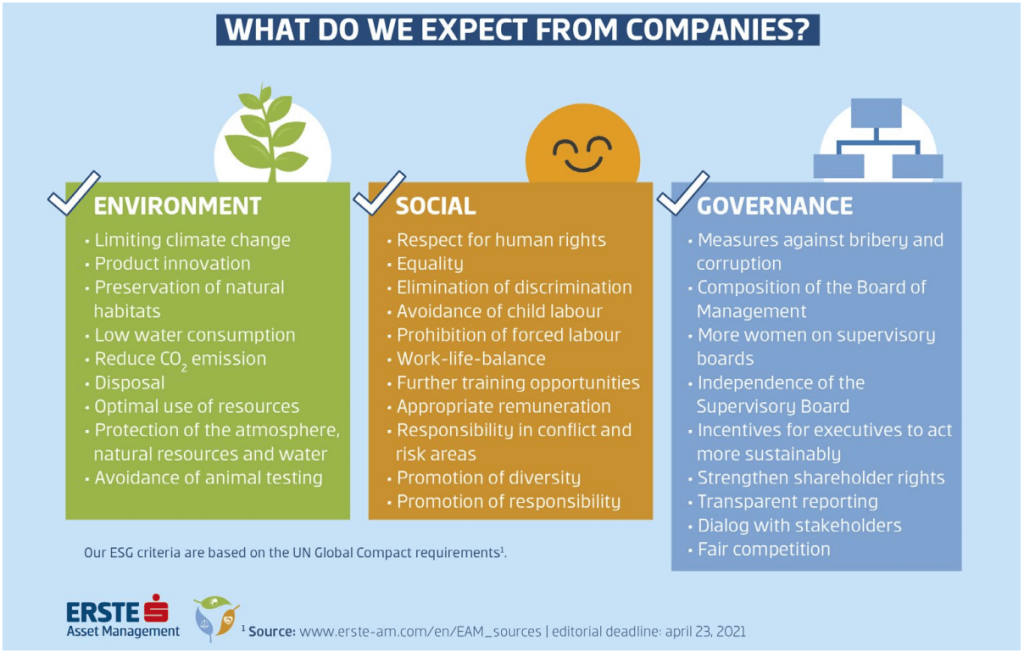How can a company optimise its relations to its employees? How can the same company maintain good relations with the regions it operates in while also taking into account the political environment? These questions address the “S” in ESG and what role it plays in the evaluation of a company.
Separating the S from the ESG would, globally speaking, be a dubious act, as E, S, and G are inseparably linked. For example, the global climate crisis also affects human rights such as the right to water or topics like child and forced labour, which due to droughts and extreme weather happen more frequently. The unfair treatment of indigenous people by exploitative employers can also lead to a situation where already scarce resources are exploited even more, e.g. when the soil is not being cultivated sustainably. Good governance structures help companies when it comes to facing risks in the E and S segments.
In the following, we would first like to lay out a regulatory framework on the basis of the analysis of S-topics in our investment processes. We shall also give examples where the engagement with companies has yielded systems that can recognise social challenges. They show how, for example, targeted incentive systems can translate into positive achievements for the region and/or employees.
How to address the S?
As sustainable investors, we have concerned ourselves with the use of social indicators in company and state evaluation for more than ten years. Companies with evidence of human or labour law violations will not be considered for our sustainable investments. This includes child labour, forced labour and human trafficking.
In addition, we subject the S-performance of companies to a thorough analysis and juxtapose the social risks and social performance of companies. The number of topics described in this context is comprehensive and includes, for example, supply chain management, workplace safety standards, and incentive systems such as training programmes. At the end, only those companies are selected that have an optimal grip on their risks and act on the basis of the highest ethical standards.

School or work: children in the cocoa industry
One of the most extensive engagement projects that we have so far been involved in with regard to social topics deals with child labour in the cacao supply chain.
According to estimates by the International Cacao Initiative, almost five in ten children that live in a region that grows cacao work in cacao production instead of going to school. This situation affects in particular small agricultural families in Ghana and in Côte d’Ivoire who suffer from poverty, hunger, drinking water shortage, and limited access to education. Many children work on cacao farms with their close or distant relatives – which is not necessarily child labour.
The International Labour Organization (ILO) defines child labour as “work that deprives children (any person under 18) of their childhood, their potential and their dignity, and that is harmful to their physical and/or mental development.” The organisation also distinguishes between kinds and duration of labour. Hazardous activities such as carrying heavy loads, using sharp tools, working for too many hours or working instead of going to school is to be classified as child labour. This is not the same as forced labour though, where children are forced to work under threat of punishment in the case of non-compliance. Child trafficking, where children are taken from their protected environment to be exploited elsewhere is another different category altogether.

In our engagement teams, we have cooperated with our partner Sustainalytics since 2018. Our goal has been to address child labour and forced labour in the supply chains of the biggest cacao producers and to improve the working conditions of cacao farmers. However, since 2020 the situation has deteriorated again, not the least due to the COVID-19 pandemic. Estimates from ILO and UNICEF suggest that by the end of 2022, another nine million children may be forced into child labour as a consequence of the pandemic. Also, the situation might get worse for children who already work, given that their conditions might get worse or they might have to work even more. This gets exacerbated further by armed conflicts and natural disasters, seeing as the risk of children having to work instead of going to school rises during times of displacement and hardship.
We did see positive developments in the cacao industry, at least prior to 2019: according to a study by NORC at the University of Chicago, 7% more children in Ghana and 20% more in Côte d’Ivoire attended school in 2018/19 than in 2008/09.
Living income & bonus for sustainable agriculture
Since the beginning of the engagement we have attended and contributed to about 75 meetings with well-known companies such as Mondelez, Nestlé, PepsiCo, Tesco, and Barry Callebaut. The main point on the agenda were discussions about how to ensure living income for the workers on the cacao farms and how to measure the current income of the respective households.
Receiving a living income is generally considered a human right, as laid down in article 23 of the Declaration of Human Rights, “Everyone who works has the right to just and favourable remuneration ensuring for himself and his family an existence worthy of human dignity, and supplemented, if necessary, by other means of social protection.” The definition of a living income that cannot be called into question includes the costs of nutritional, affordable meals in line with regional customs, and the costs of simple and adequate housing. It also takes into account clothing, education, transport, and reserves for unforeseeable events.
The “Forum Fairer Handel” points out that the establishment of the relevant numbers is particularly challenging for agricultural businesses due to the poor availability of income and expense data. This is exacerbated by the fact that the global market price of cacao is subject to significant fluctuations, and low prices can worsen the situation of the affected families. In order to alleviate this sub-par situation, the governments of Ghana and Côte d’Ivoire introduced a “living income differential” (LID) for 2020/21, which stipulated a premium of USD 400 per tonne of raw cacao on top of the market price at any given time.
Companies, too, have developed effective tools in order to make their supply chains more sustainable. For example, Nestlé announced the Income Accelerator Program in 2020. Here, farmers can receive bonuses by implementing specific measures. Said measures include, for example, obligatory school attendance by the children or the improvement of agricultural practices. Also, cultivated areas have to be reforested so as to strengthen the resilience of the soil, and the household income has to be diversified so as to make sure the family does not solely depend on income from cacao production. In the first two years, families can earn bonuses of CHF 500 this way by taking all the required steps. The program is to include 10,000 families in 2022 and 160,000 families by 2030.
For a glossary of technical terms, please visit this link: Fund Glossary | Erste Asset Management
Legal note:
Prognoses are no reliable indicator for future performance.
Legal disclaimer
This document is an advertisement. Unless indicated otherwise, source: Erste Asset Management GmbH. The language of communication of the sales offices is German and the languages of communication of the Management Company also include English.
The prospectus for UCITS funds (including any amendments) is prepared and published in accordance with the provisions of the InvFG 2011 as amended. Information for Investors pursuant to § 21 AIFMG is prepared for the alternative investment funds (AIF) administered by Erste Asset Management GmbH pursuant to the provisions of the AIFMG in conjunction with the InvFG 2011.
The currently valid versions of the prospectus, the Information for Investors pursuant to § 21 AIFMG, and the key information document can be found on the website www.erste-am.com under “Mandatory publications” and can be obtained free of charge by interested investors at the offices of the Management Company and at the offices of the depositary bank. The exact date of the most recent publication of the prospectus, the languages in which the fund prospectus or the Information for Investors pursuant to Art 21 AIFMG and the key information document are available, and any other locations where the documents can be obtained are indicated on the website www.erste-am.com. A summary of the investor rights is available in German and English on the website www.erste-am.com/investor-rights and can also be obtained from the Management Company.
The Management Company can decide to suspend the provisions it has taken for the sale of unit certificates in other countries in accordance with the regulatory requirements.
Note: You are about to purchase a product that may be difficult to understand. We recommend that you read the indicated fund documents before making an investment decision. In addition to the locations listed above, you can obtain these documents free of charge at the offices of the referring Sparkassen bank and the offices of Erste Bank der oesterreichischen Sparkassen AG. You can also access these documents electronically at www.erste-am.com.
Our analyses and conclusions are general in nature and do not take into account the individual characteristics of our investors in terms of earnings, taxation, experience and knowledge, investment objective, financial position, capacity for loss, and risk tolerance. Past performance is not a reliable indicator of the future performance of a fund.
Please note: Investments in securities entail risks in addition to the opportunities presented here. The value of units and their earnings can rise and fall. Changes in exchange rates can also have a positive or negative effect on the value of an investment. For this reason, you may receive less than your originally invested amount when you redeem your units. Persons who are interested in purchasing units in investment funds are advised to read the current fund prospectus(es) and the Information for Investors pursuant to § 21 AIFMG, especially the risk notices they contain, before making an investment decision. If the fund currency is different than the investor’s home currency, changes in the relevant exchange rate can positively or negatively influence the value of the investment and the amount of the costs associated with the fund in the home currency.
We are not permitted to directly or indirectly offer, sell, transfer, or deliver this financial product to natural or legal persons whose place of residence or domicile is located in a country where this is legally prohibited. In this case, we may not provide any product information, either.
Please consult the corresponding information in the fund prospectus and the Information for Investors pursuant to § 21 AIFMG for restrictions on the sale of the fund to American or Russian citizens.
It is expressly noted that this communication does not provide any investment recommendations, but only expresses our current market assessment. Thus, this communication is not a substitute for investment advice.
This document does not represent a sales activity of the Management Company and therefore may not be construed as an offer for the purchase or sale of financial or investment instruments.
Erste Asset Management GmbH is affiliated with the Erste Bank and austrian Sparkassen banks.
Please also read the “Information about us and our securities services” published by your bank.


